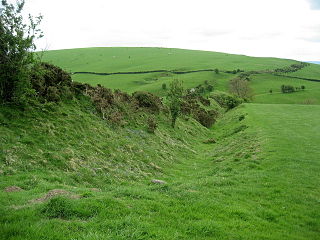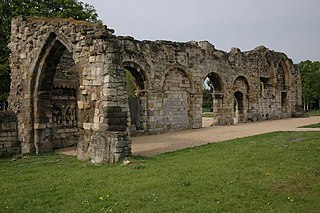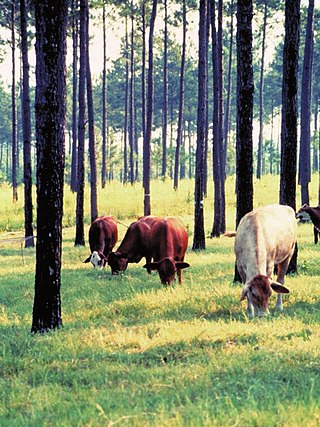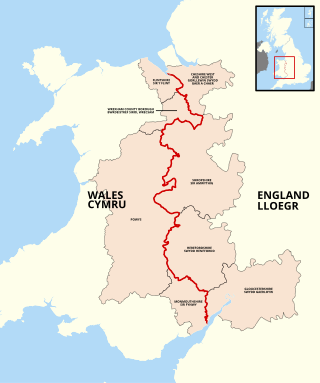
Alfred the Great was King of the West Saxons from 871 to 886, and King of the Anglo-Saxons from 886 until his death in 899. He was the youngest son of King Æthelwulf and his first wife Osburh, who both died when Alfred was young. Three of Alfred's brothers, Æthelbald, Æthelberht and Æthelred, reigned in turn before him. Under Alfred's rule, considerable administrative and military reforms were introduced, prompting lasting change in England.

Offa's Dyke is a large linear earthwork that roughly follows the border between England and Wales. The structure is named after Offa, the Anglo-Saxon king of Mercia from AD 757 until 796, who is traditionally believed to have ordered its construction. Although its precise original purpose is debated, it delineated the border between Anglian Mercia and the Welsh kingdom of Powys.

Mercia was one of the three notable Anglic kingdoms founded after Sub-Roman Britain was settled by Anglo-Saxons in an era called the Heptarchy. It was centred around the River Trent and its tributaries, in a region now known as the Midlands of England.

Offa was King of Mercia, a kingdom of Anglo-Saxon England, from 757 until his death. The son of Thingfrith and a descendant of Eowa, Offa came to the throne after a period of civil war following the assassination of Æthelbald. Offa defeated the other claimant, Beornred. In the early years of Offa's reign, it is likely that he consolidated his control of Midland peoples such as the Hwicce and the Magonsæte. Taking advantage of instability in the kingdom of Kent to establish himself as overlord, Offa also controlled Sussex by 771, though his authority did not remain unchallenged in either territory. In the 780s he extended Mercian Supremacy over most of southern England, allying with Beorhtric of Wessex, who married Offa's daughter Eadburh, and regained complete control of the southeast. He also became the overlord of East Anglia and had King Æthelberht II of East Anglia beheaded in 794, perhaps for rebelling against him.
Year 893 (DCCCXCIII) was a common year starting on Monday of the Julian calendar.

Æthelred, Lord of the Mercians became ruler of English Mercia shortly after the death or disappearance of its last king, Ceolwulf II in 879. Æthelred's rule was confined to the western half, as eastern Mercia was then part of the Viking-ruled Danelaw. His ancestry is unknown. He was probably the leader of an unsuccessful Mercian invasion of Wales in 881, and soon afterwards he acknowledged the lordship of King Alfred the Great of Wessex. This alliance was cemented by the marriage of Æthelred to Alfred's daughter Æthelflæd.

Wiglaf was King of Mercia from 827 to 829 and again from 830 until his death. His ancestry is uncertain: the 820s were a period of dynastic conflict within Mercia and the genealogy of several of the kings of this time is unknown. Wigstan, his grandson, was later recorded as a descendant of Penda of Mercia, so it is possible that Wiglaf was descended from Penda, one of the most powerful seventh-century kings of Mercia.

The Major Oak is a large English oak near the village of Edwinstowe in the midst of Sherwood Forest, Nottinghamshire, England. According to local folklore, it was Robin Hood's shelter where he and his merry men slept. It weighs an estimated 23 tons, has a girth of 33 feet, a canopy of 92 feet, and is about 800–1000 years old. In 2014, it was voted 'England's Tree of the Year' by a public poll by the Woodland Trust, receiving 18% of the votes. Its name originates from Major Hayman Rooke's description of it in 1790.

Savernake Forest stands on a Cretaceous chalk plateau between Marlborough and Great Bedwyn in Wiltshire, England. Its area is approximately 4,500 acres.

Archenfield is the historic English name for an area of southern and western Herefordshire in England. Since the Anglo-Saxons took over the region in the 8th century, it has stretched between the River Monnow and River Wye, but it derives from the once much larger Welsh kingdom of Ergyng.

Silvopasture is the practice of integrating trees, forage, and the grazing of domesticated animals in a mutually beneficial way. It utilizes the principles of managed grazing, and it is one of several distinct forms of agroforestry.
Hastein was a notable Viking chieftain of the late 9th century who made several raiding voyages.

Buttington is a village in Powys, Wales, less than 3 km from Welshpool and about 300 m from the River Severn, in the community of Trewern. The Montgomery Canal passes through the village. The village stands on a slight rise above the river's floodplain, by the ancient ford called Rhyd-y-groes, where Offa's Dyke meets the Severn. The ford retained strategic value: reportedly in 1039 a battle took place here between Welsh and English forces.
Events from the 9th century in England.

The England–Wales border, sometimes referred to as the Wales–England border or the Anglo-Welsh border, runs for 160 miles (260 km) from the Dee estuary, in the north, to the Severn estuary in the south, separating England and Wales.

Long Mountain is a hill straddling the boundary between Powys (Wales) and Shropshire (England) to the east of Welshpool though the summit at 408 metres at Beacon Ring is within Wales. Long Mountain is a Marilyn, having a prominence of 305 metres.
This article is about the particular significance of the century 801–900 to Wales and its people.
The Battle of Buttington was fought in 893 between a Viking army and an alliance of Anglo-Saxons and Welsh.

The Oak at the Gate of the Dead, or Crogen Oak is a veteran tree in Wrexham County Borough, Wales. Located near the 8th-century Offa's Dyke, the tree is thought to be more than 1,000 years old. The tree is located near the site of the 1165 Battle of Crogen, and is named for a supposed burial site of battle dead nearby.
The Battle of Benfleet was an 894 battle between the Vikings and the Anglo-Saxons commanded by Edward the Elder and Æthelred, Lord of the Mercians, the son and son-in-law of Alfred the Great respectively. The battle was part of a campaign started by the Vikings in 892 to raid and potentially occupy lands in England, having been defeated by the armies of France. As part of this campaign the invaders were supported by those Vikings who had settled in England following an earlier invasion launched in 865. The battle was a victory for the Anglo-Saxons who successfully captured a number of women and children, as well as capturing or destroying the Viking ships.














